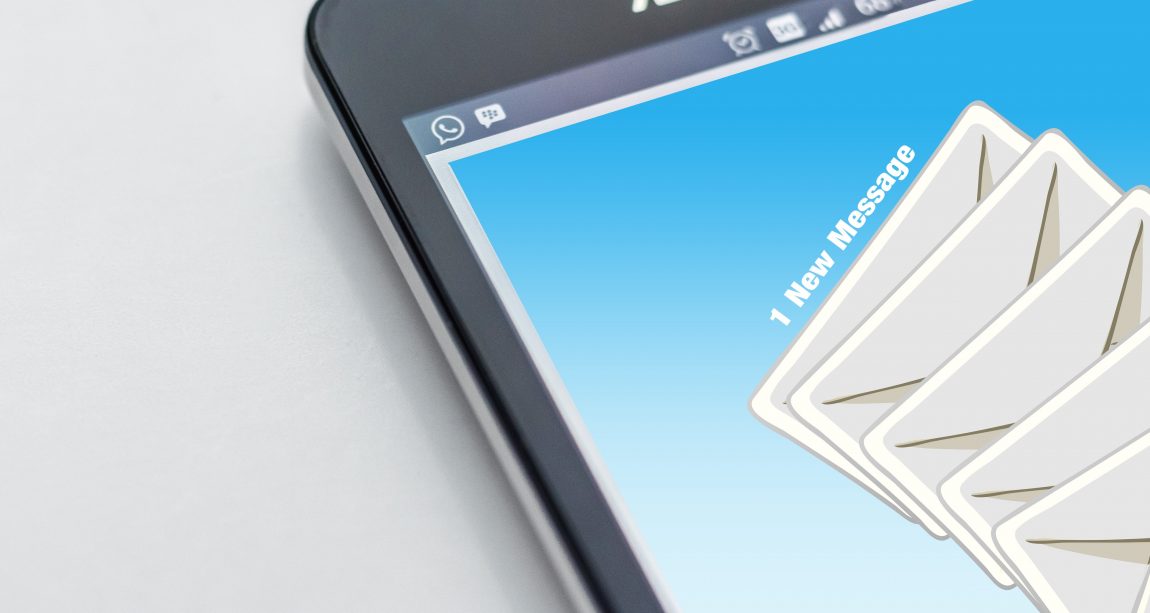Five Don’ts of B2B Email Marketing
by MGB2B
As a B2B marketer, maintaining a positive relationship is vital to your sales funnel. One of the best ways to do that is through B2B email marketing. It’s one of the most productive lead generation tools, but there are many ways to overstep your boundaries. When it comes to content, accessibility, and frequency, here are five things to keep in mind as you construct your next email campaign.
1. Sending Too Frequently
Many things are better in moderation, and marketing emails are no exception. We know what you’re thinking: we just told you that staying in touch with your customers is important. But flooding their inbox can have the opposite effect. Your customers receive hundreds of emails like yours, and it’s your job to ensure your email doesn’t get lost in the clutter. By sending emails less frequently, your customers will be less likely to feel badgered and opt out of future communications.
2. Lack of or Excess Personalization
There’s lots of talk of personalization these days, and with good reason. Consumers want to feel attended to and known. In fact, 82 percent of marketers reported an increase in open rates through email personalization, while 75 percent believe that personalization yields higher click-through rates. But keep in mind, this is more than simply a “Dear So & So.” It’s about knowing what your customers want. Sending them emails with products that match their previous interactions with you is one way to do it. But if you send them emails for products that don’t match their interest, or worse, products they’ve already purchased, your emails will become more white noise in their inbox.
This has to be done with a deft hand, however. Too much personalization can be a turn off in a creepy, big brother sort of way. It’s all about balance, folks. Fine tune your efforts so personalization is gradual, purposeful, and accurate.
3. Mobile-Unfriendly Layout
Though people still use their desktops, more and more people stay on top of their email from their phones. It’s important to make sure your content is optimized for all devices. If your images don’t load or your text is wonky, you can expect a swift delete.
4. Poorly Written Content
Customers are savvy. An elementary voice, grammatical errors, or poorly written content suggest your company shouldn’t be taken seriously. Furthermore, body copy that’s too wordy will be a turn off because no one has the time to read a tome.
5. Bad Subject Line
The subject line is the first written content your customer sees, and will define whether they open or delete it. Short, to the point, with just enough hook to pique their curiosity is the way to go. Otherwise, your email content will never be seen.
Considering that today’s marketers need to do more with less, email marketing gives us a whole lot of bang for our buck. And while other marketing trends come and go, email marketing remains a workhorse. To use it to its fullest potential, make sure you keep yours in line with the tips above.
Continue ReadingLooking Ahead to 2018: The Year of Data-Driven Marketing for B2B
by MGB2B
Data-driven marketing refers to marketing insights, strategy, and decisions that arise from the analysis of data about or from consumers. It is one of the most transformational changes in the history of advertising. Data-driven marketing takes the answers to the questions like Who, What, When, Where, and Why and makes the answers actionable.
The Benefits of B2B Data
- Enables marketers to focus advertising efforts on businesses that are more likely to be receptive
- Identifies new leads and promotional opportunities using hyper-targeting
- Ensures that existing sales and business relationships are stable and successful through nurturing and growth
Ultimately, investing in data collection and analysis can produce valuable insights that improve your campaign performance, which often translates into increasing your bottom line, while providing more meaningful advertisements to customers.
How to Collect Meaningful Data – Pre-Campaign
Now that the many benefits of data are clear, how do you go about collecting meaningful data for your company? The first step is identifying what you know and what you don’t know. If you’re interested in understanding your customers better and building buyer personas, a Consumer Research Study could be the route to take. Or if new product development is one of your 2018 goals, perhaps a Product Development Survey would be best. Understanding knowledge gaps in your organization is the first step in defining your research parameters and getting at the information you desire.
How to Use Data to Inform Your Online Campaigns
Surveys are a great way to collect data. But they aren’t the only way. Some of the most important data is collected as your digital campaigns are running. For instance, Paid Search campaigns are only made better by tracking the performance of several ads. Over time, the data tells you which messages are resonating with which audience segments, which times of the day ads are performing, etc. You can use information from email campaigns similarly, testing to see which subject lines and messages perform best and using the data to make your campaign more effective. These are just two examples. Online testing and fine-tuning should be a big part of your marketing strategy in 2018 if you are not already doing it.
Investing in Audience Growth
When you conduct research and testing with the goal of gaining insight into your target audience, not only will you have a set of data points describing them, but you will have a deeper understanding of their thoughts, feelings, and motivations. You will have answers to the questions Who, What, When, Where, and Why. With this information, you can create targeted campaigns keyed into specific points that appeal to your audience.
For example, let’s say you learn through research that factory owners are not just concerned with OSHA compliance, but also feel an emotional connection to protecting the lives of their employees through safe work environments. You can take that piece of emotional information and apply it to your messaging, helping factory owners connect with what you’re saying on a deeper level. If you learn architects visit certain industry websites more often than others, tailor your media plan to highlight that website. If contractors tend to open emails more at night than throughout the day, customize your email campaign to launch at 9 pm instead of 10 am. Small tidbits such as these can reveal themselves through detailed research, and become game-changers in the development of your entire marketing strategy.
When considering marketing initiatives to pursue in 2018, marketing research and testing should be top priorities. Gaining a deeper understanding of audience behavior is crucial, especially as outreach becomes more digitally focused each year. And in 2018, we will continue to see this trend develop and blossom. Time to dive in head-first!
Continue ReadingB2B Myth of the Week: All Your Salespeople Need Is the Gift of Gab
by MGB2B
 The Myth: A Smooth-Talking Salesperson Needs No Tool
The Myth: A Smooth-Talking Salesperson Needs No Tool
The Truth: Even the Best in the Business Should Have Some Tools Up Their Sleeves
In the words of Ben Affleck in the movie Boiler Room, “In every business interaction, a sale is made. Either you sell the client or they sell you on a reason they can’t use you.” It’s a Hollywood notion that the best salespeople can sell anything to anyone with nothing but the art of persuasion.
While there are some salespeople who fit this mold, in this day and age, the more tools they have in their arsenal, the better. B2B brands are seeing a higher demand for content, especially visual content, than ever before. Now is a crucial time for businesses to provide tools and train their sales teams on how to use them. You might think that visual content is a B2C tactic, but as Gary Vaynerchuk says, “behind every B is a C.”
It’s important for salespeople to acknowledge the art of the sale is not just about the pitch, but about how you get them to hear your pitch in the first place.
Here Are 3 Types of Content All B2B Salespeople Should Consider Including in Their Toolbelts:
- Infographics – A Creative Way to Present the Facts. B2B doesn’t have to be all about lists and spreadsheets. Infographics will have a lot more impact on prospects. Start off by creating a few of them (you can do this with a tool like PiktoChart, use an in-house designer, or hire a B2B marketing agency to create them) so that your salespeople have them ready to go. While infographics are often used on social media or email marketing programs, salespeople can also present them to lukewarm prospects as a door-opener. “I thought you might find this infographic on _________ helpful as you go into the New Year.”
- White Papers – Persuading from a Different Angle. White papers can be used in multiple ways. Primarily, they serve an educational purpose. But they also provide salespeople with an interactive and engaging way to provide a counter-rebuttal to the challenges you receive from prospects. White papers should be as colorful, well-designed, and engaging as infographics. Perhaps the most important thing that a white paper can do is give your brand authority and credibility. They might be just the right push to give your prospect reason enough to choose your brand over a competitor’s.
- Video Marketing – The Most Memorable Sales Tool. Marketers everywhere know how important video is heading into 2018. It is one of the most effective and memorable ways to get a point across to sales prospects. Try incorporating video into your sales pitch instead of talking about how great your product/service is. A video can accomplish this in many different ways: from How-To Guides to Live Video Chats to Engaging Case Studies. The level of video production doesn’t have to be on par with a Hollywood movie. Research has proven that content and creativity are important, but the value of the video is what most people remember.
Natural sales talent is important, but it should be complemented by something more substantial. With your competition likely jumping into the content marketing game, it’s important to do it right. Make sure your marketing team and your sales team are working together to create and distribute content in ways that propel the brand forward. Each member of the team should have the tools they need to drive prospects along the sales funnel. The goal is the same for everyone in your organization: conversion.
Continue Reading
